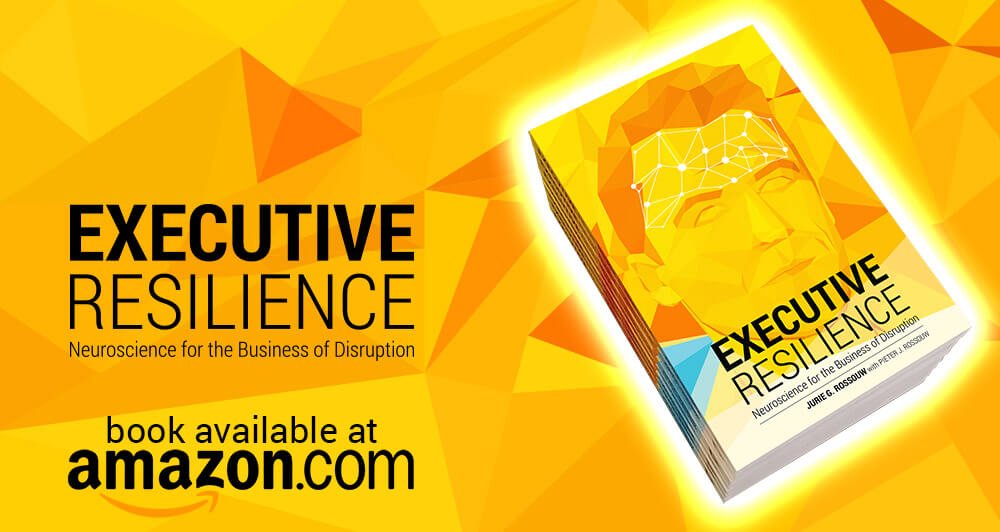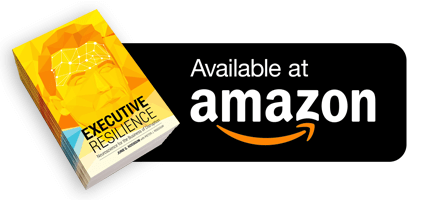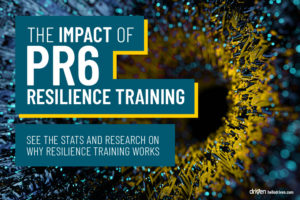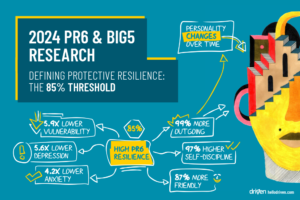Executive Resilience: Neuroscience For The Business of DisruptionHappy to announce Executive Resilience – my new book! This book explores the impact of automation and artificial intelligence on the global consciousness, resulting in increased uncertainty that wears down wellness. The cover art illustrates how anyone (including myself) may suddenly find an automated worker take their place. How do we as individuals and organisations manage such rapid change? Resilience is presented as a solution – not just a nice-to-have, but an imperative skill needed to thrive in an environment of constant disruption. We expand on:
- The importance of resilience – why now?
- The six domains of resilience – what are the implications for organisations?
- Building resilience as a leader – self-regulation and leading by example
- The neuroscience of cultural resilience – leading people to thrive through change & disruption
Introduction
Now’s not a good time. There’s a lot of change right now. We’re in a middle of a restructure. Think back—how frequently are you saying this? How frequently do people say it to you when talking about a new initiative? Is there any organisation right now that’s not in the middle of some big change or restructure? These days, corporate change triggers cascading disruptions that seem to only have a middle—no beginning or end. Change morphs and permeates organisations, tearing through with endless aftershocks. Yet somehow we still hold on to the belief that some mythical time will come when there is no change and we can calmly sip a peppermint tea while considering new initiatives with clear minds and full budgets. ‘Let’s talk about it when things have settled down.’ Does it ever settle down? Even if the calm seems to come, there’s the magma of another disruption building below our feet, ready to erupt with pyroclastic flow enveloping our calendars. Surely, soon the smoke will clear to reveal free days where we can finally get all those bearings we keep talking about. In simpler times, big businesses worried about what their big competitors were doing. There was clarity in what to look for and where to look for it. The players were familiar and there was time to react. On a calm morning we could read the newspaper, on actual paper. Now in calm, we find only stagnation—the slow death of competitive edge. Our competitors obsess about disruption. Change is not enough anymore. We need to shake the very foundations to be notable. These disruptions can come not just from established competitors, but from tech behemoths or invisible start-ups. We don’t even know where to look. We’ve left the age of information. We are now in the age of information overload. We no longer face constant change. We now face accelerating disruption. This weighs on us, more than we tend to admit. The mental impact is becoming like a global tax on society as we try to ignore the psychological impacts of this fast pace. But like a tell-tale brain beating in our heads, it refuses to be ignored. What do we do with this? Do we learn to cope—to survive? Survival does not help. It creates a state in the brain that supresses our ability to be strategic and design our own disruptions. A state that pervades culture and immobilises innovation. Exactly the gap that competitors need to storm the podium. It’s not about survival. Rapid change and disruption won’t be leaving us any time soon. This is our new reality. A reality that makes it harder than before to find a sense of wellness. Therefore, we must explore a different path. A path that allows us to embrace an ever-changing world. A state of mind that creates clarity in the chaos. This is the path of resilience. Resilience is not just about bouncing back—it is so much more. Resilience is about purpose, preparation, access to strategies, and the constant advancement of ourselves and our world. Resilience contains the mechanisms needed for our achievement of wellness and by extension, the very means through which we realise our purpose. We should not fear change, nor should we grit our teeth and hold on with white knuckles while another round of restructures rip through. We should revel in these times, confident in our preparation, agility, and ability to transmute any situation into fuel for our personal drive. We must learn to value the potential destruction of what we know… and trust in our ability to reassemble the shattered pieces in mid-air into something even better. There’s no time to wait for our feet to rest on the ground. Humanity isn’t walking anymore—we are running. There’s no sign of slowing down. If we choose to fight for relevance and leap the boundaries of business, then we need to embrace this reality. Resilience teaches us a mindset that is hard to embrace, but infinitely rewarding. It is the fundamental disruption of our own values. We then learn to look away from the blinding lure of happiness—after all, pursuing happiness directly brings anything but. Resilient people find what is truly of value is struggle, learning, challenge, growth. This fundamental re-evaluation of values brings exhilaration and excitement even in our toughest moments. We gain a surge to our sense of purpose far greater than what the pursuit of happiness could ever bring. No longer would we need to wait for things to ‘settle down’. Now is always the right time to consider the value of an idea. Now is always the right time to adapt programs and integrate what might be the critical innovation that’s needed to advance. Constant change can become an additional happy place, with resilience the prerequisite for this mental agility. However, we cannot expect this flexibility without resilience education. Fortunately, neural structures are ready to be rewired for resilience. Like an old house, the wiring starts out hidden and confusing. With time, effort and investment, the old house becomes a modern masterpiece. The discovery of neuroplasticity shows us that no one is too old or too young to change. This ability to change, combined with our inherent social nature, means we can all work on this together. The growth to be achieved is not only worth striving for, it’s quantifiably necessary for the future. We are heading towards one trillion dollars lost each year due to poor mental health—resilience is necessary. How much more could we accomplish together if we collectively embrace the biggest challenges ahead? Resilience removes fear. A veritable vaccine against intolerance. It opens the pathway for us to fully embrace each other and our differences. Imagine the depth of compassion we can reach through the collective struggle of diverse people towards meaningful, shared goals. Forget survival—to truly live in the world that we are running into, we need to build our collective resilience. Organisations, more than any other, need to develop cultures of resilience. Through an integration of neuroscience, psychology and management knowledge, we can transform our global culture. This is the goal of Executive Resilience.All the best,
Jurie




